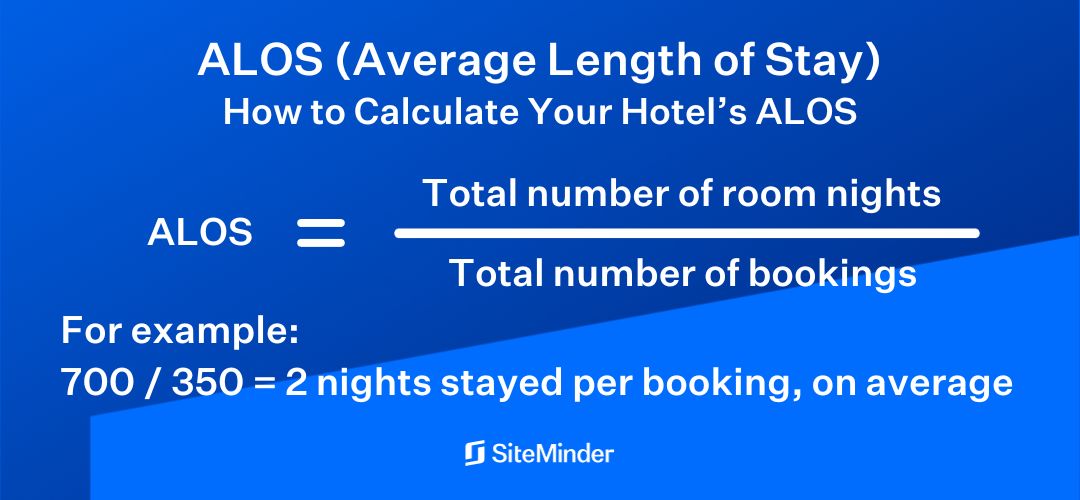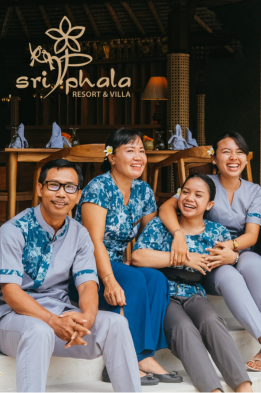What is ALOS?
ALOS is an abbreviation that means ‘average length of stay.’ In the hotel industry, it refers to the average number of nights guests stay at your property over a given time.
For example, if your ALOS was 4.5 in the third quarter of the year, each booking during that quarter was for 4.5 days on average.
ALOS usually shifts throughout the year, depending on the season and its respective travel patterns.
It also differs depending on the property type, location and target market. Resorts that welcome mostly leisure guests often have a longer average length of stay. On the other hand, city properties with a focus on business travellers usually see guests stay fewer days.
In this article, you’ll find everything you need to know about ALOS, and how to use it to further improve your property’s results.
Table of contents
What is the average length of stay in the hospitality industry?
The average length of stay, commonly referred to as ALOS, is a pivotal metric that hoteliers around the world employ to gauge the performance and health of their business. At its core, ALOS measures the average number of nights a guest spends at a hotel. A higher ALOS typically indicates that guests are choosing to stay longer, translating to increased room revenue and potentially higher guest satisfaction. It’s a simple equation: more nights equal more revenue.
However, while the allure of a high ALOS is undeniable, it’s essential to approach this metric with nuance. There isn’t a universal “golden number” for ALOS that suits all hotels. Factors such as the hotel’s category (luxury vs budget), its geographical location, seasonal trends, and its target demographic can all influence what a “good” ALOS looks like for that particular establishment.
To illustrate, consider some industry data: Hotel Tech Report cites that the average length of stay for a typical US hotel hovers around 1.8 nights. Meanwhile, Statista presents a comparable figure for New Zealand hotels, averaging 1.7 nights. But a closer examination of the New Zealand statistics reveals intriguing nuances: motels and serviced apartments in the country boast a higher ALOS of 2.1 nights, while backpacker accommodations outpace them all with an impressive average of 3.15 nights. This is nearly double the average for standard hotels!
Does this disparity suggest that backpacker accommodations are inherently more successful or lucrative than traditional hotels? Not quite. Backpacker lodgings cater to a distinct demographic: travellers, often younger, seeking longer stays at budget-friendly rates. If a luxury hotel were to pivot its strategy to chase a similar ALOS, it might inadvertently alienate its core clientele and dilute its brand value.
While ALOS serves as a valuable barometer for hotel performance, it’s not a standalone metric. It’s imperative for hoteliers to contextualise ALOS within their specific market segment, location, and business model. And, as with all metrics, it’s most effective when considered alongside other key performance indicators to paint a holistic picture of a hotel’s success. Improve your ALOS with SiteMinder Our tailored hotel platform helps you entice more guests to stay with you for longer.

How do you calculate the average length of stay?
Calculating the average length of stay is easy. Determine the average length of stay for guests at your hotel by following these steps:
- Add up the number of room nights booked for a given time (e.g. one month, quarter or a custom period).
- Add up the number of reservations for the same time.
- Divide the number of room nights by total reservations to get your ALOS.
ALOS formula for calculating average length of stay
Average length of stay = Total number of room nights / Total number of bookings.

What is an example of average length of stay?
The New Dawn Hotel in Miami is a 30-room hotel, with a maximum room night capacity of 900 for the month of April. Over April, there were 700 room nights booked, split between 350 individual bookings.
Average length of stay = 700 / 350 = 2 nights stayed per booking, on average
Why is it important to track the average length of stay at your hotel?
Understanding your hotel’s average length of stay can help you on several fronts. First, ALOS reveals booking patterns across seasons and during events. This allows you to create pricing and distribution strategies that maximise high-demand periods and continue to drive business even when things slow down.
Second, knowing how your ALOS shifts during the year lets you run your operations more efficiently. For example, it’ll be easier for you to schedule cleaning, maintenance and front-of-house teams, because you can gauge the level of guest turnover.
Optimise your pricing and maximise room revenue
SiteMinder connects with leading revenue management systems to automatically update your optimised rates across all distribution channels in real-time, maximizing the yield of every room through intelligent pricing.
Learn More
Five tips to improve ALOS and maximise business revenue
As a rule of thumb, long stays are better for your operation’s profitability. They mean fewer check-ins and check-outs, less time spent cleaning rooms and fewer resources devoted to generating new bookings. So, let’s look at how you can increase the length of stay at your property.
1. Set a minimum length of stay booking restriction
Minimum stay restrictions are the most straightforward way to increase ALOS since they simply don’t allow shorter bookings. They work best during high-demand times, e.g. over holidays or important trade shows, when the majority of travellers are willing to stay longer.
Avoid using these rules as a year-round blanket solution though as this could cause you to lose bookings during low season.
2. Make longer stays more attractive with LOS pricing and packages
LOS pricing is a more flexible alternative to rigid minimum stay requirements. It means implementing pricing rules that calculate rates based on the check-in date and the length of stay. This way you offer guests a more attractive deal if they book extra nights.
Alternatively, you could promote packages such as “4 for 3” or “7 for 6.” Especially during the low season this can encourage longer stays because the discount makes more people think “why not?”.
3. Entice guests to spend more time
If you want guests to stay longer, make the idea irresistible by highlighting all the activities and services at your hotel and in the nearby area. For example, promote your spa or showcase the many day trips that are possible from your property.
By providing a variety of options, you cater to a range of interests and give guests a good reason to stick around.
4. Make it easy to extend the stay
Once guests are in-house you’ve got another chance to encourage them to tack on an extra day or two. Reach out to them the day before they check out and offer an attractive deal such as a free dinner or 10% off if they extend for a night. You can do this by calling their room or, better yet, via an automated email, SMS or other forms of direct messaging.
This lets guests choose on their own time instead of putting them on the spot. Digital communication also allows you to include a link where travellers can easily see the conditions and extend in just a few clicks. The simpler you make this step, the more guests will take you up on the offer.
5. Target remote workers with attractive deals
The remote work trend is here to stay, so why not cater to flexible employees? Offer packages including everything they need such as high-speed Wi-Fi, desk space, F&B credits, a laundry allowance and other perks. That will make your property their top pick next time they want to work from a new location.
Implementing just a few of the tips above is quick and can help you drive up your property’s average length of stay. Given the many advantages of a higher ALOS, it’s more than worth it to put in this time and effort.
So, brainstorm how you could use these ideas at your hotel and get to work. It won’t be long until you start seeing the benefits of welcoming guests for longer stays.

